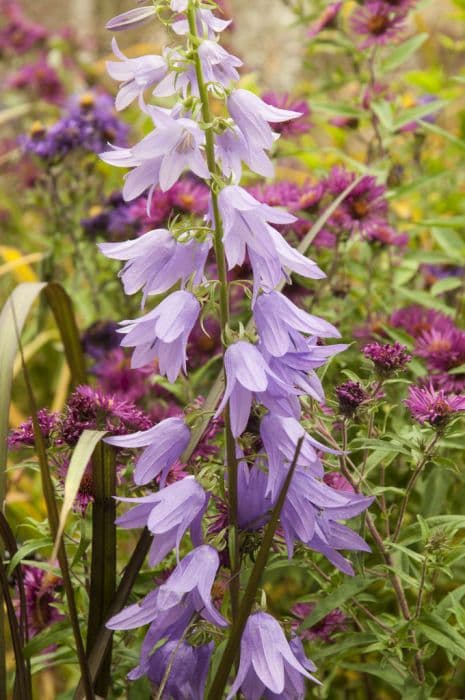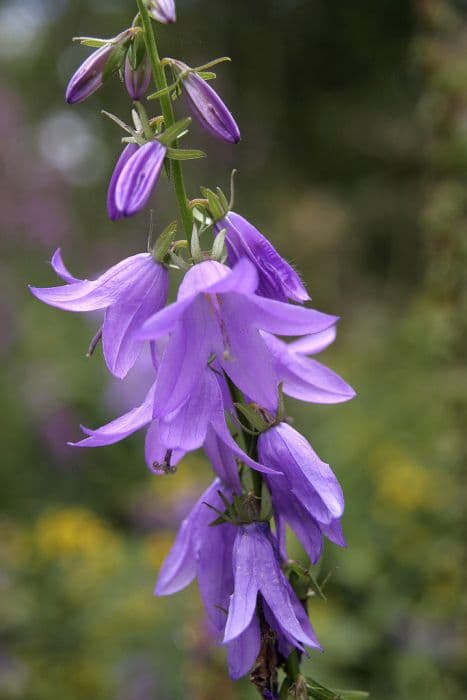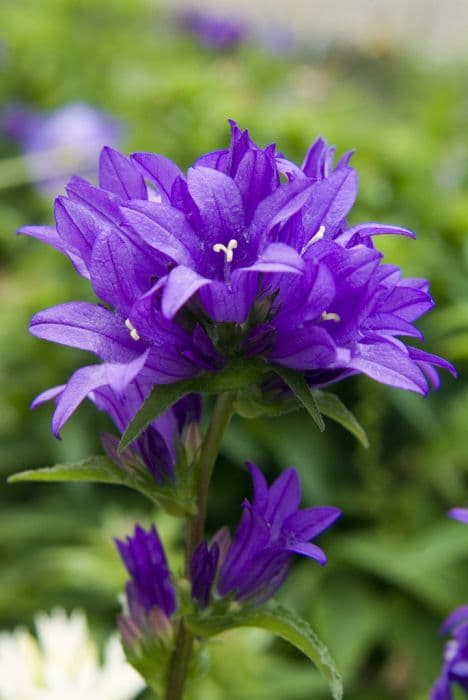Bellflower Campanula 'Crystal'

ABOUT
The Campanula 'Crystal', often referred to as Bellflower 'Crystal', is a striking plant characterized by its appealing flowers and lush foliage. The bellflower exhibits a profusion of star-shaped blooms that bear the classic bell-like form, from which its common name is derived. These flowers are notable for their radiant and clear color, which can range from a deep, vivid blue to a soft lilac or sometimes pristine white, creating a stunning visual display. The foliage of the Bellflower 'Crystal' is made up of lush green leaves that form a dense mound or clump, providing a lush backdrop for the beautiful blossoms. These leaves are typically broad and have a somewhat heart-shaped base, tapering to a point. They may have serrated or smooth edges and are soft to the touch, growing in a rosette pattern that emanates from the base of the plant. The contrast between the delicate flowers and the robust greenery is a defining trait of the Bellflower 'Crystal'. It is a plant favored not only for its beauty but also for the charming and graceful aura it lends to gardens or containers where it is grown, attracting pollinators such as bees and butterflies. The overall appearance is one of enchantment and vibrant life, emblematic of the fairy-tale charm that this plant brings to any landscape.
About this plant
 Names
NamesSynonyms
Bellflower, Canterbury Bells
Common names
Campanula 'Crystal'
 Toxicity
ToxicityTo humans
Campanula 'Crystal', commonly known as bellflower, is not considered toxic to humans. Ingesting parts of this plant typically does not cause poisoning or severe symptoms. However, as with any plant material, individual sensitivities can vary, and ingesting plant matter may cause mild stomach upset in some people.
To pets
Campanula 'Crystal', also known as bellflower, is generally considered non-toxic to pets such as cats and dogs. It is not known to cause any significant symptoms of poisoning if ingested. While it is usually safe, consuming large amounts may result in mild gastrointestinal upset for some pets due to the ingestion of non-food items.
 Characteristics
CharacteristicsLife cycle
Perennials
Foliage type
Deciduous
Color of leaves
Green
Flower color
Blue
Height
1-2 feet (30-60 cm)
Spread
1-2 feet (30-60 cm)
Plant type
Herb
Hardiness zones
3-8
Native area
Europe
Benefits
 General Benefits
General Benefits- Attracts pollinators: Campanula 'Crystal' is known to attract bees and butterflies, which are beneficial for the pollination of many garden plants.
- Low maintenance: Being a hardy perennial, it requires little care once established, making it ideal for gardeners of all skill levels.
- Aesthetic appeal: With its delicate bell-shaped flowers and dense foliage, it adds visual interest and beauty to garden beds and borders.
- Drought tolerant: Once established, it can tolerate periods of dryness, making it suitable for xeriscaping and low-water gardens.
- Edible parts: Some parts of the plant are edible and can be used in salads or as a garnish, though not commonly consumed.
- Ground cover: It can serve as an effective ground cover, filling in garden spaces and helping to prevent weed growth.
- Versatile planting options: Can be planted in containers, hanging baskets, or directly in the garden, offering a range of landscaping uses.
 Medical Properties
Medical PropertiesThis plant is not used for medical purposes.
 Air-purifying Qualities
Air-purifying QualitiesThis plant is not specifically known for air purifying qualities.
 Other Uses
Other Uses- Fairy gardens: The petite and delicate flowers of Campanula 'Crystal' make it an ideal addition to fairy gardens, where it can create a whimsical, miniature landscape.
- Edible decoration: The flowers of Campanula 'Crystal' are edible, though not commonly consumed, and can be used to adorn salads or desserts for a touch of elegance.
- Photography: The distinct bell-shaped flowers provide a beautiful subject for macro photography, perfect for hobbyists and professional photographers alike.
- Art inspiration: Artists can use the intricate form and vibrant hues of Campanula 'Crystal' as inspiration for botanical illustrations and other art pieces.
- Wedding bouquets: Because of their charming and romantic appearance, these flowers can be included in wedding bouquets or as part of the table centerpieces.
- Pressed flower crafts: The blooms of Campanula 'Crystal' are ideal for pressed flower projects, like bookmarks, cards, or framed art, due to their flat shape when pressed.
- Textile dyeing: The petals can be used in natural dyeing processes to impart color to textiles, although this use is not widespread.
- Floral ice cubes: Freeze small Campanula 'Crystal' flowers in ice cubes to create eye-catching additions for summertime drinks or punch bowls.
- Teaching tool: Use Campanula 'Crystal' in botany classes to demonstrate the characteristics of the Campanulaceae family, or illustrate principles such as pollination and plant growth patterns.
- Culinary garnish: While not a common culinary herb, the gentle appearance of Campanula 'Crystal' can be used to garnish specialty dishes, adding visual appeal to culinary presentations.
Interesting Facts
 Feng Shui
Feng ShuiThe Bellflower is not used in Feng Shui practice.
 Zodiac Sign Compitability
Zodiac Sign CompitabilityThe Bellflower is not used in astrology practice.
 Plant Symbolism
Plant Symbolism- Gratitude – The bell-shaped flowers of the Campanula, often referred to as Bellflower, are seen as a symbol of gratitude due to their resemblance to upturned, open hands receiving blessings or giving thanks.
- Constancy and Perseverance – Bellflowers have a hardy nature and can endure various conditions, symbolizing the ability to stand firm and persist through challenges.
- Vulnerability and Delicacy – The fragile appearance of the Campanula's flowers, with their thin petals and gentle hues, often signifies vulnerability and the delicate aspects of life.
- Unwavering Love – In the language of flowers, Bellflowers are sometimes associated with the idea of endless love that stands the test of time, reflecting unwavering affection and fidelity.
- Hope and New Beginnings – The Campanula blooms in the spring and summer months, conveying a sense of hope and the promise of new beginnings as nature awakens.
 Water
WaterBellflower 'Crystal' prefers consistent moisture, so it is important to water it when the top inch of soil feels dry to the touch. This might mean watering once a week, but can vary depending on environmental conditions. It's best to provide the plant with about one gallon of water each time, ensuring that the soil is moist but not waterlogged. During the growing season, increase water frequency as needed, especially in hot, dry weather. In winter, reduce watering but do not let the soil dry out completely.
 Light
LightBellflower 'Crystal' thrives under full sun to partial shade conditions. The ideal spot for this plant is a location where it receives morning sunlight and afternoon shade, especially in hotter climates. Make sure the plant is protected from the harsh afternoon sun to prevent leaf scorch.
 Temperature
TemperatureBellflower 'Crystal' prefers temperate conditions and can tolerate a range of temperatures. The plant does best in temperatures between 50°F and 85°F. It can survive minimum temperatures down to around 30°F but should be protected from frost and extreme cold, which could damage the plant.
 Pruning
PruningPrune Bellflower 'Crystal' to remove dead or faded flowers and to shape the plant. This encourages new growth and a second bloom in some varieties. Pruning should be done after the first flush of flowers has finished, typically in midsummer. Trim the plant back by one-third to maintain a healthy, compact form and encourage additional blooming.
 Cleaning
CleaningAs needed
 Soil
SoilThe Bellflower 'Crystal' thrives best in a well-draining soil mix that is rich in organic matter, such as a blend of loamy soil, peat moss, and perlite. The ideal pH range for this plant is between 6.0 and 7.5, which is slightly acidic to neutral.
 Repotting
RepottingBellflower 'Crystal' typically should be repotted every two to three years, or when it has outgrown its current container, to provide fresh soil and encourage continued growth.
 Humidity & Misting
Humidity & MistingBellflower 'Crystal' prefers a moderate humidity level, consistent with average room humidity, making it suitable for typical home environments.
 Suitable locations
Suitable locationsIndoor
Place in bright, indirect light and keep soil moist.
Outdoor
Plant in partial sun, shelter from strong winds, ensure moist soil.
Hardiness zone
4-9 USDA
 Life cycle
Life cycleCampanula 'Crystal', commonly known as bellflower, begins its life cycle as a seed which, under appropriate conditions of moisture and temperature, germinates. The seed develops into a seedling, which will then establish roots and a rosette of basal leaves. As the plant matures, it sends up stalks and produces distinctive bell-shaped flowers which are often blue, purple, or white in color. After pollination by insects, the flowers produce fruit in the form of capsules containing tiny seeds. These seeds are dispersed by wind, water, or animals, and when they land in a suitable environment, the cycle recommences with new germination. In some climates, the bellflower may act as a perennial, surviving through winter and flowering each year, while in other areas it is treated as an annual or biennial.
 Propogation
PropogationPropogation time
Spring-Early Summer
Campanula, commonly known as Bellflower 'Crystal', is typically propagated through division, which is the most popular method for this particular plant. The best time to propagate by division is in the spring or early fall, when the plant is not in active bloom and the temperatures are mild, to ensure quick establishment. To propagate by division, one should gently lift the entire plant from the ground, ensuring as much of the root system as possible is kept intact. Using a sharp, clean knife or garden spade, divide the plant into smaller sections, each with an adequate amount of roots and shoots. These divisions can then be replanted at the same depth they were growing at previously, spaced approximately 12 inches (about 30 centimeters) apart to allow room for growth. Water the new plants thoroughly and maintain consistent moisture until they are well established.








